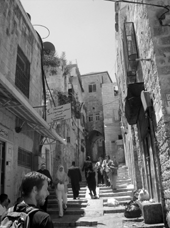
As my friends and I climbed into the Servees in Ramallah none of us really knew what to expect of the day. It would be the furthest away within the West Bank any of us had been. It was the closest we could be to the Lebanon border while remaining safely within the Occupied territory. It was a community known for its fierce resistance to the Occupation.
We were heading to Jenin.
"I have been in urban environments where house to house fighting has happened: Rwanda, Nicaragua, El Salvador, Colombia, and a city struck by a massive earthquake: Mexico city. The devastation seen in Jenin camp had the worst elements of both situations. Houses not just bulldozed or dynamited but reduced almost to dust by the repeated and deliberate coming and goings of bulldozers and tanks. Houses pierced from wall to wall by tank or helicopter gun ships. Houses cut down the middle as if by giant scissors. Inside, an eerie vision of dining or bedrooms almost intact. No signs whatsoever that that bedroom or dining room or indeed the house had been used by fighters. Gratuitous, wanton, unnecessary destruction. ChildrenÂ’s prams, toys, beds everywhere. Where were those children? I do not know, but I do know where the survivors will be in the future."
- Javier Zuniga Amnesty International's Director of Regional Strategy after entering Jenin refugee camp on 17 April 2002
The Israeli Defense Forces, only four years ago conducted Operation Defensive Shield in which it entered densely populated residential areas such Jenin and Nablus, and laid siege to both the Muqatta'a - Arafat's compound in Ramallah that I drive by nearly everyday - and the Basilica of the Nativity in Bethlehem (a subject I will address in particular in a later post).
Jenin had produced a disproportionate amount of fighters in the second Intifada and was thus subject to particular brand of Israel's now famous collective punishment. In early April of 2002, the IDF cordoned off Jenin City and Jenin Refugee Camp. They ordered everyone out of the Camp but like in Lebanon, not everyon understood or complied with this command. The IDF arrested dozens of men - stripped them to their underwear and dropped them in neighbouring communities and ordered them not to return to Jenin.
Amnesty International reports that the IDF then used Palestinian civilians as human shields (I guess Hezbollah aren't the only ones who do this?) to search each house for boobytraps that were planted by the 120 or so Palestinian soldiers that decided to stay in Jenin and fight. And as their tanks and foot soldiers rolled into the streets and alleys of the Camp they encountered heavy resistance. The IDF changed their tactics, and using the armoured bulldozers that have brought such misery throughout the Occupied Territories, they cut large swathes out of the camp. Homes were systematically destroyed and their occupants crushed to death. Journalists and humanitarian workers were denied entry into the camp and the world watched in horror as Apache Helicopters fired missile after missile into the densely populated residential area.
Jenin is a city that has been though a lot.
And it was into this camp that we were heading.
***
Picture:
Jenin: Hundreds of bullet holes in the side of a house
Read about Operation Defensive Shield...

1 comment:
I found your page while cruising random blogs, I will be back to read and look at great photos...
Post a Comment